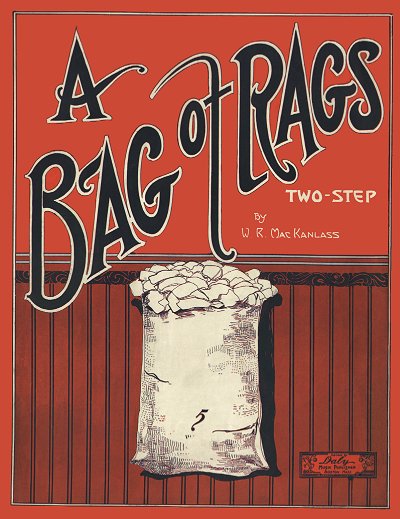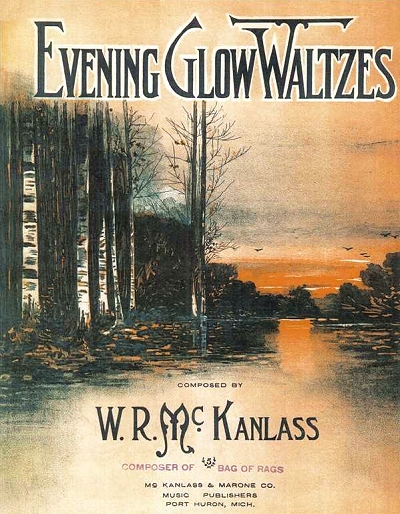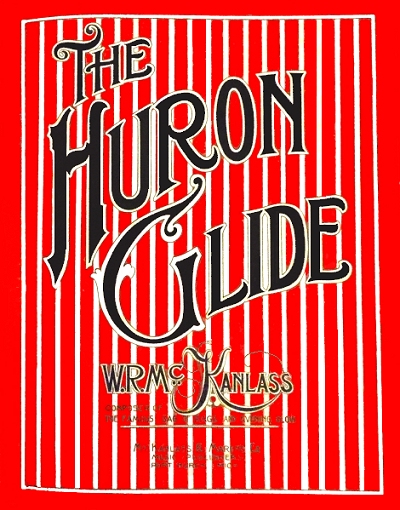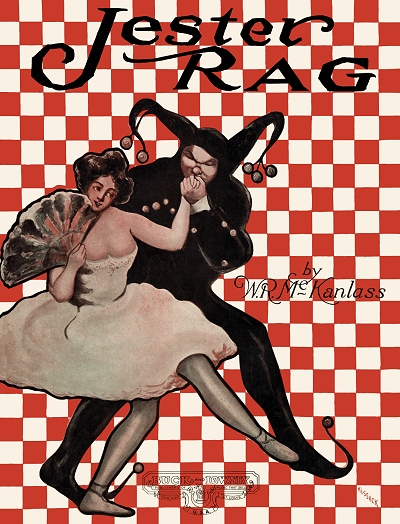 William Rudolph McKanlass (February 27, 1879 - January 9, 1937) |
 Compositions Compositions |
|
1912
A Bag of RagsEvening Glow Waltzes 1913
The Huron Glide1917
Jester Rag1918
They're All After Me [w/Thomas August] |
William R. McKanlass was born on the frontier in Manhattan, Kansas, just as the state was becoming a vital agricultural center, and around the same time as a number of Kansas and Missouri musicians were born as well. In this instance, however, it was likely where the family happened to be at that time, as it was not where he would be raised. William was born to esteemed African-American musician William H. McKanlass of Oklahoma (Indian Territory at that time) and his Kentucky-born wife Susan H. Griffin. The elder McKanlass, born around 1858, was trained on the violin but was also an accomplished cornetist. The family was shown living in Manhattan, Kansas, for the 1880 enumeration, with William, Sr., working as a barber. They soon relocated east to southern Ohio where William graduated from the Cincinnati [Ohio] College of Music in 1883, the same year that young William's sister Patricia was born. His education was enhanced by schooling in Leipzig, Germany and Paris, France, although it is unclear if the family accompanied him there. The McKanlass family had settled permanently in Ohio by the mid-1880s, and W.H. became the first African American music instructor in the Cincinnati Public Schools late in the decade. He was also offered the role of Chief Musician of the U.S. Army Ninth Cavalry, the famed Buffalo Soldiers unit, soon achieving the rank of Captain, under the command of General Edward Hatch. W.H. also taught banjo, violin and voice privately.
In addition to his duties with the Army and as a teacher, Captain McKanlass also found time during a few summers in the 1880s and 1890s to tour the country as well. The names of his troupe varied, including The McKanlass Alabama Warblers, The Great McKanlass Colored Specialty Company and The Great McKanlass Colored Comedy Company. There are reports that McKanlass was quite well off, receiving between $500 and $1000 a week for his talents, a substantial sum in the 1890s and early 1900s. The troupe's performances included stints in California, Washington State, Montana, Yellowstone National Park in Wyoming, Illinois, Wisconsin, Minnesota, and likely on some of the Chautauqua circuits of that era as well. While it has been reported that Professor McKanlass earned $500 a day at Yellowstone, this may refer instead to the entire troupe, but it is still an impressive figure. One mid-1890s handbill notes "The Great McKanlass" performing in Minnesota, featuring his self-written play Shooting Crapps.  He also did stage comedy and acts of musical prowess, one of which reportedly included performing on two cornets, two banjos, two harmonicas, and six other instruments, all at once on stage. His success was such that he was noted as among the first black violinists to own his own automobile.
He also did stage comedy and acts of musical prowess, one of which reportedly included performing on two cornets, two banjos, two harmonicas, and six other instruments, all at once on stage. His success was such that he was noted as among the first black violinists to own his own automobile.
 He also did stage comedy and acts of musical prowess, one of which reportedly included performing on two cornets, two banjos, two harmonicas, and six other instruments, all at once on stage. His success was such that he was noted as among the first black violinists to own his own automobile.
He also did stage comedy and acts of musical prowess, one of which reportedly included performing on two cornets, two banjos, two harmonicas, and six other instruments, all at once on stage. His success was such that he was noted as among the first black violinists to own his own automobile.During these travels young William went along as both a drummer and banjoist. He additionally played tuba and trombone. There is a probability, based on his obituary, that his mother was also a pianist, and that he may have learned this skill from her. During some of the tours he was advertised as "Master Willie, the smallest Drum Major in the world." While this was in part due to his young age, there is some truth to that as William only grew to a height of 5'4" as an adult. In addition to working with his father, William traveled with Price's Georgia Minstrels along with prominent black and black-face stars of the time, and acted in a series of Uncle Tom's Cabin presentations. The latter company was based in Kalamazoo, Michigan, the state he would eventually permanently live in. As a teen, Mac, as he would be called, took piano lessons from Madame Caroline Hubbard Webb, a respected Ohio born black music teacher living in Chicago, Illinois. It was said that he was highly retentive when it came to music, able to play virtually anything he heard nearly immediately.
After many years of traveling as a youth, and with a lot of professional music training on his resume, Mac moved to Port Huron, Michigan, around 1899. He may have been traveling at the time the 1900 census was taken, and could not be found in it. In 1902 Mac married Miss Minnie Harris of Sarnia, Ontario, Canada, just across the St. Clair River and Sarnia Bay from Port Huron. At first he was performing around the area and working as a music teacher for piano and drums. Mac was not shy about joining any civic organizations as well, forwarding good causes of the black people in the area as well as people in general. For the 1910 census Mac and Minnie were living in Port Huron and he was listed as a musician.
There is a likelihood that Mac was part of the Detroit inner circle of black performers that dominated southeastern Michigan, and performed with them on several occasions, even though he did very well for himself in Port Huron as well. Detroit was a hotbed of ragtime activity with Fred S. Stone and Harry P. Guy leading much of it. With that exposure as well as his history it is no surprise that he would compose a rag or two. The surprise is that not much else can be located, even though there were many reports, including his obituaries, that he composed fairly often. His first and most enduring piece was A Bag of Rags in 1912. Probably self-published at first, then picked up by Daly Music in Chicago it saw widespread circulation. Whether Mac received royalties for it or if the piece was bought outright is unknown. It was popular enough to become the "unofficial" theme of Mack Sennett's Keystone Kops, which is said to have recommended the piece in the suggested music lists occasionally sent out with the distributed films.  That same year Mac self-published Evening Glow Waltzes, a lovely set of melodies that eventually made it onto a couple of piano rolls. Some editions of the cover had "Composer of Bag of Rags" hand-stamped on them in order to capitalize on the growing success of that piece which had been released around the same time. He was assisted by local Italian merchant and violinist Rox Marone, forming McKanlass and Marone Music Publishers. In 1913 their label released the Huron Glide, a popular dance number that saw some circulation in Michigan. The pair maintained an office at 309 1-2 Huron avenue for several years. Marone also played from time to time with McKanlass when allowed, as the populous of Michigan were generally more tolerant of mixed race performance groups.
That same year Mac self-published Evening Glow Waltzes, a lovely set of melodies that eventually made it onto a couple of piano rolls. Some editions of the cover had "Composer of Bag of Rags" hand-stamped on them in order to capitalize on the growing success of that piece which had been released around the same time. He was assisted by local Italian merchant and violinist Rox Marone, forming McKanlass and Marone Music Publishers. In 1913 their label released the Huron Glide, a popular dance number that saw some circulation in Michigan. The pair maintained an office at 309 1-2 Huron avenue for several years. Marone also played from time to time with McKanlass when allowed, as the populous of Michigan were generally more tolerant of mixed race performance groups.
 That same year Mac self-published Evening Glow Waltzes, a lovely set of melodies that eventually made it onto a couple of piano rolls. Some editions of the cover had "Composer of Bag of Rags" hand-stamped on them in order to capitalize on the growing success of that piece which had been released around the same time. He was assisted by local Italian merchant and violinist Rox Marone, forming McKanlass and Marone Music Publishers. In 1913 their label released the Huron Glide, a popular dance number that saw some circulation in Michigan. The pair maintained an office at 309 1-2 Huron avenue for several years. Marone also played from time to time with McKanlass when allowed, as the populous of Michigan were generally more tolerant of mixed race performance groups.
That same year Mac self-published Evening Glow Waltzes, a lovely set of melodies that eventually made it onto a couple of piano rolls. Some editions of the cover had "Composer of Bag of Rags" hand-stamped on them in order to capitalize on the growing success of that piece which had been released around the same time. He was assisted by local Italian merchant and violinist Rox Marone, forming McKanlass and Marone Music Publishers. In 1913 their label released the Huron Glide, a popular dance number that saw some circulation in Michigan. The pair maintained an office at 309 1-2 Huron avenue for several years. Marone also played from time to time with McKanlass when allowed, as the populous of Michigan were generally more tolerant of mixed race performance groups.By the middle of the 1910s Mac and Minnie were able to purchase a home at 610 Beers in downtown Port Huron, where they would live the rest of their respective lives. In 1917 he would release one final published composition, Jester Rag, which was taken on by Buck and Lowney of St. Louis, Missouri and Chicago, Illinois. On his 1918 draft record, Mac is listed as a self-employed musician. From around 1907 into the early 1920s McKanlass had variously a small orchestra, then his own trio/quartet, a group that had acquired a good measure of fame locally. It is clear that during many of those years the group, with McKanlass at the piano, was playing nearly every week, especially in the summer and during holiday periods. They were usually situated at the classic Windermere Hotel, the resident group for many years. In a series of advertisements in 1919 for the group in the Yale [Michigan] Expositor, his versatility was clearly touted by his employer:
Boys, McKanlass says he aims to show us that all the good musicians don't hail from Detroit, and we all know that when Mac lets out a link or two he can certainly go some. Get ready for a big time and we'll show Mac that we can dance anything he can play. McKanlass 4-piece Orchestra
Tragedy struck during the fall of 1919 when Minnie died on September 22, evidently from chloroform anesthesia. The death certificate claims it was not during a surgery, so the circumstances that led to this are uncertain. In the January 1920 census Mac was shown as widowed and still listed as a musician. His sister, now Patti Moultrie, was visiting her brother when the record was taken, likely to help him through that difficult period.
After years of working and perhaps some extra professional training as well, Mac eventually secured a job teaching music with the public schools in Port Huron. He was already a popular music teacher in the private sector with students traveling from all around St. Clair County and even across the border into Sarnia for lessons on drums, piano, guitar and accordion. Mac became very involved with the community, becoming a charter member of the Chamber of Commerce in Port Huron, as well as either membership with or performing for the Kiwanis Club, The Exchange, The Rotary Club and The Lions Club. He often assembled shows for these organizations, which included other entertainers as well as sing-alongs. It was said in Mac's obituary that his ability to pick up a tune instantly was invaluable in this regard. Also popular across the border in Canada, he was a member of Chatham Lodge Number 9, F. & A. M., Chatham, Ontario. Professionally McKanlass was a long time member of the National Academy of Music and the Port Huron Musicians Union No. 33.
Mac became very involved with the community, becoming a charter member of the Chamber of Commerce in Port Huron, as well as either membership with or performing for the Kiwanis Club, The Exchange, The Rotary Club and The Lions Club. He often assembled shows for these organizations, which included other entertainers as well as sing-alongs. It was said in Mac's obituary that his ability to pick up a tune instantly was invaluable in this regard. Also popular across the border in Canada, he was a member of Chatham Lodge Number 9, F. & A. M., Chatham, Ontario. Professionally McKanlass was a long time member of the National Academy of Music and the Port Huron Musicians Union No. 33.
 Mac became very involved with the community, becoming a charter member of the Chamber of Commerce in Port Huron, as well as either membership with or performing for the Kiwanis Club, The Exchange, The Rotary Club and The Lions Club. He often assembled shows for these organizations, which included other entertainers as well as sing-alongs. It was said in Mac's obituary that his ability to pick up a tune instantly was invaluable in this regard. Also popular across the border in Canada, he was a member of Chatham Lodge Number 9, F. & A. M., Chatham, Ontario. Professionally McKanlass was a long time member of the National Academy of Music and the Port Huron Musicians Union No. 33.
Mac became very involved with the community, becoming a charter member of the Chamber of Commerce in Port Huron, as well as either membership with or performing for the Kiwanis Club, The Exchange, The Rotary Club and The Lions Club. He often assembled shows for these organizations, which included other entertainers as well as sing-alongs. It was said in Mac's obituary that his ability to pick up a tune instantly was invaluable in this regard. Also popular across the border in Canada, he was a member of Chatham Lodge Number 9, F. & A. M., Chatham, Ontario. Professionally McKanlass was a long time member of the National Academy of Music and the Port Huron Musicians Union No. 33.Always busy, Mac performed from time to time with bands and orchestras in Detroit, and did some occasional musical arrangements for musical groups as well. From the mid-1920s forward his orchestra averaged seven or more pieces in size. Port Huron also had its own fine civic organization, the Port Huron City Band, of which Mac was the bass drum player, likely from the 1910s forward after mixed races were accepted in that group. He was curiously the accompanist for the somewhat outdated Schubert-Exchange Minstrel Shows once or twice a year until they finally fizzled out. Mac's groups, starting with his quartet, then succeeded by his larger ensembles, performed every summer at the Lakeside Dance Pavilion from its opening in 1918 through 1933.
Personally Mac was well regarded by all citizens of the city. At the time of his death it was noted that he had a large library of popular, standard and classical music, in addition to a large section of books on music history and theory. Among his students outside of school were many who were underprivileged and would not have otherwise been able to learn music if not for his generosity. This included those with physical disabilities. One interesting quote from his obituary was that Mac had "probably played 'America' on the piano more times than any other local resident, playing it in accompaniment to group singing of the anthem at the close of each service club meeting." As of the 1930 enumeration he was still living on Beers Street, listed as a teacher. At this time Pattie was widowed and shown residing with him as well.
Happiness once again came into Mac's home life when he married widow Mrs. Bertha Brown of Detroit on January 28, 1932. In the exchange he acquired a stepson, Herbert Alexander, a stepdaughter, Alice Hewitt, and a granddaughter, Betty Ann Hewitt, who he particularly enjoyed teaching music to. Now approaching his mid-fifties, Mac actually increased his activities as a musician and teacher during the Great Depression, rather than pull back. For either economic or personal reasons his band did not perform their usual summer gigs in 1934 and 1935. However, they returned to the Pavilion in 1936, and planned to do so again the following summer. In late December the pace of constant work caught up with McKanlass and he started to show signs of illness. During the first week of January he felt a cold coming on and received some medical care. On Friday night, January 8, 1937, Mac conducted his dance band for an engagement at the Marysville Clubhouse of the Thumb District Edison Club. He did not feel well the entire evening. After a coughing spell around 3:00 AM the next morning, Bertha called a physician to the house, but by the time help arrived W.R. McKanlass was gone, the victim of a cerebral hemorrhage just a few weeks short of his 58th birthday.
Now approaching his mid-fifties, Mac actually increased his activities as a musician and teacher during the Great Depression, rather than pull back. For either economic or personal reasons his band did not perform their usual summer gigs in 1934 and 1935. However, they returned to the Pavilion in 1936, and planned to do so again the following summer. In late December the pace of constant work caught up with McKanlass and he started to show signs of illness. During the first week of January he felt a cold coming on and received some medical care. On Friday night, January 8, 1937, Mac conducted his dance band for an engagement at the Marysville Clubhouse of the Thumb District Edison Club. He did not feel well the entire evening. After a coughing spell around 3:00 AM the next morning, Bertha called a physician to the house, but by the time help arrived W.R. McKanlass was gone, the victim of a cerebral hemorrhage just a few weeks short of his 58th birthday.
 Now approaching his mid-fifties, Mac actually increased his activities as a musician and teacher during the Great Depression, rather than pull back. For either economic or personal reasons his band did not perform their usual summer gigs in 1934 and 1935. However, they returned to the Pavilion in 1936, and planned to do so again the following summer. In late December the pace of constant work caught up with McKanlass and he started to show signs of illness. During the first week of January he felt a cold coming on and received some medical care. On Friday night, January 8, 1937, Mac conducted his dance band for an engagement at the Marysville Clubhouse of the Thumb District Edison Club. He did not feel well the entire evening. After a coughing spell around 3:00 AM the next morning, Bertha called a physician to the house, but by the time help arrived W.R. McKanlass was gone, the victim of a cerebral hemorrhage just a few weeks short of his 58th birthday.
Now approaching his mid-fifties, Mac actually increased his activities as a musician and teacher during the Great Depression, rather than pull back. For either economic or personal reasons his band did not perform their usual summer gigs in 1934 and 1935. However, they returned to the Pavilion in 1936, and planned to do so again the following summer. In late December the pace of constant work caught up with McKanlass and he started to show signs of illness. During the first week of January he felt a cold coming on and received some medical care. On Friday night, January 8, 1937, Mac conducted his dance band for an engagement at the Marysville Clubhouse of the Thumb District Edison Club. He did not feel well the entire evening. After a coughing spell around 3:00 AM the next morning, Bertha called a physician to the house, but by the time help arrived W.R. McKanlass was gone, the victim of a cerebral hemorrhage just a few weeks short of his 58th birthday.As a testament to his standing in the community, there were several reports of his death and an accounting of his life in Port Huron papers, and his funeral on January 11 was both well covered and well attended by people of all races. The Musicians Union #33 and the Port Huron City Band attended in their entiriety, with the band playing Nearer My God to Thee at the funeral home, then Chopin's Funeral March and Handel's Dead March In Saul during the procession, with the casket carried by members of his orchestra. Former students, members of the service organizations, city leaders and many out of town mourners came to pay their respects. Once at Lakeside cemetery, they played Playel's Hymn as the body was lowered into the grave. The service ended as D. V. Graziadei, conductor of the city band, played taps. In his obituary it was clear he had an idea that the end was coming. " 'What is more lovely than to die in the profession you love?' he asked Mrs. McKanlass almost prophetically a few days ago when she chided him for rehearsing strenuously when he did not feel well." How lovely to express that feeling that most musicians who live their life bringing joy to others feel.
Some of the information for this biography was extracted from information compiled by Suzette Bronley, whose page can be found at http://www.rootsweb.ancestry.com/~mistcla2/McKanlass.htm. Additional information came from editions of the Port Huron Times Herald in editions from January 9 to January 12, 1937. The cover of Evening Glow Waltzes was obtained from the Toronto Reference Library and the music can be found on the detailed ragtime site of Canadian researcher Ted Tjaden. The remaining information was researched by the author in public records, periodicals and period sources from around the country.